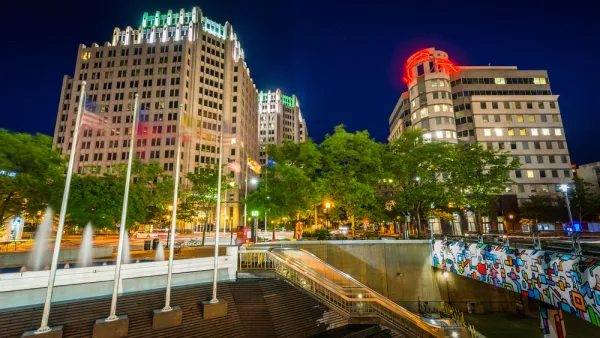A comprehensive review of the inner-ring suburb of Evanston, Illinois, outside Chicago, and a transformation Jane Jacobs would surely love. The proof is in the pudding: Evanston car ownership are far below regional averages.

"At first glance, downtown Evanston, Illinois, doesn’t look revolutionary—just another a gentrifying urban core with the obligatory Whole Foods, the local organic sustainable restaurants serving $14 cocktails, the towering new, high-end luxury apartments filled with stainless steel appliances and granite countertops," writes T.R. Goodman in a longread feature for Politico Magazine.
"It takes, in fact, a few extra minutes in the neighborhood to realize what’s different—and what’s missing. Downtown Evanston—a sturdy, tree-lined Victorian city wedged neatly between Lake Michigan and Chicago’s northern border—is missing cars. Or, more accurately, it’s missing a lot of cars. Thanks to concerted planning, these new developments are rising within a 10-minute walk of two rail lines and half-a-dozen bus routes. The local automobile ownership rate is nearly half that of the surrounding area."
Goodman traces the ideas upon which Evanston built that "concerted planning" to Jaime Lerner's example in Curitiba. Evanston adopted the Curitiba model, according to Goodman, in response to a decline that began in the 1950s as farther flung suburbs began to rack up successes. "Beginning in 1986, a new plan for Evanston embraced the idea of a '24/7' downtown, pouring resources into increasing the density of its downtown—a density that also meant decreasing residents’ reliance on automobiles. As a compact city, Evanston couldn’t compete with the vast sprawling parking spots of the Old Orchard Mall. It had to build a different sort of appeal," writes Goodman.
Explaining contemporary planning terms, inspired by Jane Jacobs and Jaime Lerner, like TOD, density, and mixed use Goodman notes that terms like those have become so mainstream. In fact, and cities all over the country have embraced these concepts:
"Today, more cities are embracing transit-oriented development and heralding it as an antidote to climate change, a cure for the anomie of our 'Bowling Alone' culture and an economic boon to cash-strapped local governments. From northeastern 'suburbs' like Arlington, Virginia, to western car-centric cities like Salt Lake to Dallas, local officials are pushing for mixed-use, high-density development within a few minutes walk of a transit line."
The article is a longread, so there is a lot more on the details of Evanston's zoning code, an explanation of the role of parking requirements in the creation of sprawl, the challenges facing a density-focused planning agenda, the still-powerful political support behind car-centric thinking, how Millennials figure into the whole redevelopment equation, and more.
FULL STORY: The Suburb That Tried To Kill the Car

Planetizen Federal Action Tracker
A weekly monitor of how Trump’s orders and actions are impacting planners and planning in America.

Chicago’s Ghost Rails
Just beneath the surface of the modern city lie the remnants of its expansive early 20th-century streetcar system.

Amtrak Cutting Jobs, Funding to High-Speed Rail
The agency plans to cut 10 percent of its workforce and has confirmed it will not fund new high-speed rail projects.

Ohio Forces Data Centers to Prepay for Power
Utilities are calling on states to hold data center operators responsible for new energy demands to prevent leaving consumers on the hook for their bills.

MARTA CEO Steps Down Amid Citizenship Concerns
MARTA’s board announced Thursday that its chief, who is from Canada, is resigning due to questions about his immigration status.

Silicon Valley ‘Bike Superhighway’ Awarded $14M State Grant
A Caltrans grant brings the 10-mile Central Bikeway project connecting Santa Clara and East San Jose closer to fruition.
Urban Design for Planners 1: Software Tools
This six-course series explores essential urban design concepts using open source software and equips planners with the tools they need to participate fully in the urban design process.
Planning for Universal Design
Learn the tools for implementing Universal Design in planning regulations.
Caltrans
City of Fort Worth
Mpact (founded as Rail~Volution)
City of Camden Redevelopment Agency
City of Astoria
City of Portland
City of Laramie





























